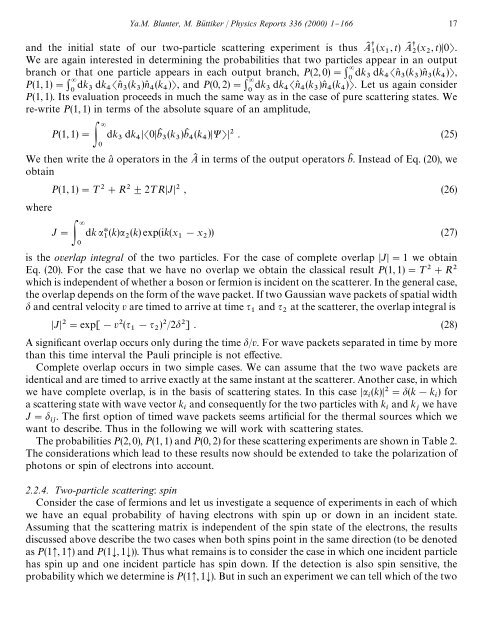shot noise in mesoscopic conductors - Low Temperature Laboratory
shot noise in mesoscopic conductors - Low Temperature Laboratory
shot noise in mesoscopic conductors - Low Temperature Laboratory
You also want an ePaper? Increase the reach of your titles
YUMPU automatically turns print PDFs into web optimized ePapers that Google loves.
and the <strong>in</strong>itial state of our two-particle scatter<strong>in</strong>g experiment is thus AK (x , t) AK (x , t)0.<br />
<br />
We are aga<strong>in</strong> <strong>in</strong>terested <strong>in</strong> determ<strong>in</strong><strong>in</strong>g the probabilities that two particles appear <strong>in</strong> an output<br />
branch or that one particle appears <strong>in</strong> each output branch, P(2, 0)"dk dk n( (k )n( (k ),<br />
<br />
P(1, 1)"dk dk n( (k )n( (k ), and P(0, 2)"dk dk n( (k )n( (k ). Let us aga<strong>in</strong> consider<br />
<br />
P(1, 1). Its evaluation proceeds <strong>in</strong> much the same way as <strong>in</strong> the case of pure scatter<strong>in</strong>g states. We<br />
re-write P(1, 1) <strong>in</strong> terms of the absolute square of an amplitude,<br />
<br />
P(1, 1)" dk dk 0bK (k )bK (k ) . (25)<br />
<br />
<br />
We then write the a( operators <strong>in</strong> the AK <strong>in</strong> terms of the output operators bK . Instead of Eq. (20), we<br />
obta<strong>in</strong><br />
P(1, 1)"¹#R$2¹RJ , (26)<br />
where<br />
<br />
J" dk H(k) (k) exp(ik(x !x )) (27)<br />
<br />
<br />
Ya.M. Blanter, M. Bu( ttiker / Physics Reports 336 (2000) 1}166 17<br />
is the overlap <strong>in</strong>tegral of the two particles. For the case of complete overlap J"1 we obta<strong>in</strong><br />
Eq. (20). For the case that we have no overlap we obta<strong>in</strong> the classical result P(1, 1)"¹#R<br />
which is <strong>in</strong>dependent of whether a boson or fermion is <strong>in</strong>cident on the scatterer. In the general case,<br />
the overlap depends on the form of the wave packet. If two Gaussian wave packets of spatial width<br />
and central velocity v are timed to arrive at time and at the scatterer, the overlap <strong>in</strong>tegral is<br />
<br />
J"exp[!v( ! )/2] . (28)<br />
<br />
A signi"cant overlap occurs only dur<strong>in</strong>g the time /v. For wave packets separated <strong>in</strong> time by more<br />
than this time <strong>in</strong>terval the Pauli pr<strong>in</strong>ciple is not e!ective.<br />
Complete overlap occurs <strong>in</strong> two simple cases. We can assume that the two wave packets are<br />
identical and are timed to arrive exactly at the same <strong>in</strong>stant at the scatterer. Another case, <strong>in</strong> which<br />
we have complete overlap, is <strong>in</strong> the basis of scatter<strong>in</strong>g states. In this case (k)"(k!k ) for<br />
<br />
a scatter<strong>in</strong>g state with wave vector k and consequently for the two particles with k and k we have<br />
<br />
J" .The"rst option of timed wave packets seems arti"cial for the thermal sources which we<br />
<br />
want to describe. Thus <strong>in</strong> the follow<strong>in</strong>g we will work with scatter<strong>in</strong>g states.<br />
The probabilities P(2, 0), P(1, 1) and P(0, 2) for these scatter<strong>in</strong>g experiments are shown <strong>in</strong> Table 2.<br />
The considerations which lead to these results now should be extended to take the polarization of<br />
photons or sp<strong>in</strong> of electrons <strong>in</strong>to account.<br />
2.2.4. Two-particle scatter<strong>in</strong>g: sp<strong>in</strong><br />
Consider the case of fermions and let us <strong>in</strong>vestigate a sequence of experiments <strong>in</strong> each of which<br />
we have an equal probability of hav<strong>in</strong>g electrons with sp<strong>in</strong> up or down <strong>in</strong> an <strong>in</strong>cident state.<br />
Assum<strong>in</strong>g that the scatter<strong>in</strong>g matrix is <strong>in</strong>dependent of the sp<strong>in</strong> state of the electrons, the results<br />
discussed above describe the two cases when both sp<strong>in</strong>s po<strong>in</strong>t <strong>in</strong> the same direction (to be denoted<br />
as P(1,1) and P(1,1)). Thus what rema<strong>in</strong>s is to consider the case <strong>in</strong> which one <strong>in</strong>cident particle<br />
has sp<strong>in</strong> up and one <strong>in</strong>cident particle has sp<strong>in</strong> down. If the detection is also sp<strong>in</strong> sensitive, the<br />
probability which we determ<strong>in</strong>e is P(1,1). But <strong>in</strong> such an experiment we can tell which of the two
















